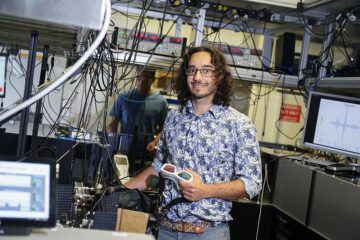Protein Inhibits Cell Growth, May Contribute to Breast Cancer

A protein known as cdk6 inhibits proliferation of some cell types and may play a role in the development of breast cancer, according to a report by researchers at National Jewish Medical and Research Center. Joseph Lucas, Ph.D., Erwin Gelfand, M.D., and Joanne Domenico, report in the February issue of Molecular Cancer Research, that breast-cancer cells have low to nonexistent levels of cdk6, while normal cells have relatively high levels. Cell growth in two tumor-cell lines dropped significantly when levels of cdk6 were increased inside the cells.
„These findings suggest a new and promising avenue of breast-cancer research,“ said Lucas, Associate Professor in the Pediatrics Department, Division of Cell Biology, at National Jewish. „Many researchers have thought that the cdk proteins only promote cell growth. But our findings support an emerging model of the cell cycle, which holds that some of them, such as cdk6, actually suppress growth of some cell types.“
Lucas, Gelfand and Domenico compared normal human breast cells with 10 breast-cancer cell lines. All 10 tumor-cell lines had significantly less cdk6 than the normal breast cells, with seven of the 10 having little or no cdk6.
Because cell lines can differ from cells in bodies, the researchers also looked at cdk6 levels in normal and tumor breast tissues taken from patients. Staining of the tissue samples indicated that normal tissue had much more cdk6 than did tumor tissue, especially in the cell nuclei, where cdk6 functions.
When these investigators inserted genes coding for cdk6 in two of the tumor-cell lines, cell growth rates dropped by about 68%. One of the tumor-cell lines lost the inserted cdk6 gene and resumed a rapid growth rate.
Additional data indicated that cdk6 may regulate a molecule known as p130, which is known to suppress cell growth. In fact, a promising class of cancer drugs, known as histone deacetylase inhibitors, may also act on p130. The researchers are now studying the effect that one of these drugs, suberoylanilide hydroxamic acid (SAHA), has on cdk6.
„These data place cdk6 as a major regulator of breast epithelial growth,“ said Dr. Gelfand, Chairman of Pediatrics at National Jewish. „They suggest that if we can keep cdk6 levels up in breast tumors, we may be able to prevent the malignant cells from dividing. Secondly, we might be able to use cdk6 as a diagnostic tool by determining if cells are normal or malignant depending upon the amount of cdk6 found in them.“
National Jewish has applied for a patent on the use of cdk6 as a marker for cancer and as a target to control cell growth.
Media Contact
Weitere Informationen:
http://www.nationaljewish.org/news/cdk6.htmlAlle Nachrichten aus der Kategorie: Biowissenschaften Chemie
Der innovations-report bietet im Bereich der "Life Sciences" Berichte und Artikel über Anwendungen und wissenschaftliche Erkenntnisse der modernen Biologie, der Chemie und der Humanmedizin.
Unter anderem finden Sie Wissenswertes aus den Teilbereichen: Bakteriologie, Biochemie, Bionik, Bioinformatik, Biophysik, Biotechnologie, Genetik, Geobotanik, Humanbiologie, Meeresbiologie, Mikrobiologie, Molekularbiologie, Zellbiologie, Zoologie, Bioanorganische Chemie, Mikrochemie und Umweltchemie.
Neueste Beiträge

Neue universelle lichtbasierte Technik zur Kontrolle der Talpolarisation
Ein internationales Forscherteam berichtet in Nature über eine neue Methode, mit der zum ersten Mal die Talpolarisation in zentrosymmetrischen Bulk-Materialien auf eine nicht materialspezifische Weise erreicht wird. Diese „universelle Technik“…

Tumorzellen hebeln das Immunsystem früh aus
Neu entdeckter Mechanismus könnte Krebs-Immuntherapien deutlich verbessern. Tumore verhindern aktiv, dass sich Immunantworten durch sogenannte zytotoxische T-Zellen bilden, die den Krebs bekämpfen könnten. Wie das genau geschieht, beschreiben jetzt erstmals…

Immunzellen in den Startlöchern: „Allzeit bereit“ ist harte Arbeit
Wenn Krankheitserreger in den Körper eindringen, muss das Immunsystem sofort reagieren und eine Infektion verhindern oder eindämmen. Doch wie halten sich unsere Abwehrzellen bereit, wenn kein Angreifer in Sicht ist?…





















